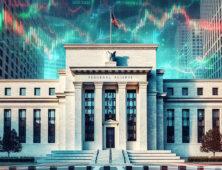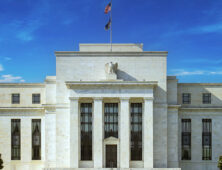Today’s Mortgage Rates in September 2025

Sept 02, 2025

1️⃣ Trump vs. The Fed: Round Two
President Trump’s war with the Federal Reserve escalated again last week with the firing of Fed Governor Lisa Cook, one of the central bank’s most dovish voices. In a move that surprised many, Cook has now filed a lawsuit challenging the President’s authority to remove her before her term ends. This sets up a potentially lengthy court battle over the independence of the Fed—a cornerstone of U.S. financial stability. Investors view central bank independence as essential to keeping monetary policy insulated from short-term political pressures. If that independence is compromised, markets tend to price in more risk, which often results in volatility across stocks, bonds, and yes—mortgage rates. For borrowers, the drama is more than political theater; it directly influences the cost of financing a home.
2️⃣Durable Goods Signal Consumer Strength
The July Durable Goods Orders report surprised to the upside, showing that both consumers and businesses are still investing despite higher financing costs. Core orders, which exclude the more volatile aircraft and defense categories, rose more than expected and point to continued confidence in the economy’s direction. Since consumer spending accounts for nearly 70% of U.S. GDP, this resilience is a critical pillar keeping the economy moving forward.
However, there’s a flip side: a stronger-than-expected consumer gives the Fed more justification to keep interest rates elevated in their fight against inflation. That tension between growth and inflation has been the defining story of 2025—and it’s one that continues to ripple through the mortgage market.
3️⃣CPI Brings Inflation Back Into Focus
The Consumer Price Index (CPI) report for July showed inflation remains a stubborn challenge. Headline CPI climbed higher, largely driven by energy and housing costs, while core inflation (which strips out food and energy) held close to expectations. Although the report wasn’t a shock, it underscored that inflation is proving sticky at levels above the Fed’s comfort zone. This complicates the outlook for future rate cuts. For homeowners and buyers, it means mortgage rates are unlikely to see sustained relief until inflation shows a more convincing downward trend. The Fed has made clear that one or two “good” reports won’t be enough—they need to see a consistent pattern before shifting policy.
💡Rates & Market Outlook
Treasury yields recently tested a strong floor of support, but have since bounced higher. This rebound has pushed mortgage rates up slightly to start the week, reinforcing the importance of timing in today’s market. The next major test comes Friday, when the Bureau of Labor Statistics (BLS) releases its monthly jobs report. Job growth has been one of the strongest tailwinds for the economy, but recent reports have been plagued by large revisions that undermined initial optimism. With new leadership now overseeing the BLS, markets are hoping for cleaner, more reliable data that will give the Fed—and borrowers—greater clarity. If the report surprises on the upside, yields could climb further, adding more pressure on mortgage rates.
Bottom Line – A Locking Bias
Between political battles over the Fed, a consumer base that refuses to slow down, and inflation that isn’t easing as quickly as hoped, there is more risk of mortgage rates heading higher than lower in the near term. While we all want relief, the safe play is to lock when possible and avoid leaving yourself exposed to the swings that continue to define this market. Protecting your buying power today ensures you’re not caught off guard tomorrow.
Aug 25, 2025

1️⃣ Powell Walks a Tightrope in Jackson Hole
At the Fed’s annual Jackson Hole conference, Jerome Powell struck a careful balance. He didn’t outright promise rate cuts, but he leaned heavily on soft labor market data and hinted that a shift in policy is likely. That was all Wall Street needed to hear. Markets instantly priced in a high probability of a September cut, with stocks and bonds both rallying.
Here’s the key takeaway: Powell is walking a fine line. On one hand, unemployment is moving higher, giving him justification to ease. On the other, tariffs and inflation pressures remain a real threat. Markets are running with the optimistic version of the story, but history reminds us—when the Fed hints at change, opportunities can come and go quickly.
2️⃣Home Purchase Cancellations Hit Record Highs
July saw nearly 58,000 home purchase contracts fall apart—about 15% of all deals under contract. That’s the highest July cancellation rate since tracking began back in 2017.
What’s behind this surge in cancellations?
- Affordability Crunch: Mortgage rates remain stuck in the mid-6% to low-7% range, and home prices are still nearly 50% higher than pre-pandemic levels. For many families, the math simply doesn’t work.
- Economic Anxiety: Buyers are nervous about where the economy is headed. Slowing job growth, talk of a potential recession, and renewed inflation worries have made households more cautious.
- More Homes to Choose From: With inventory improving in many parts of the country, buyers don’t feel the same urgency they did in 2021–2022. They can walk away knowing there may be other options tomorrow.
- Sticker Shock at Closing: Rising insurance premiums, property taxes, and HOA dues are surprising buyers late in the process, causing some to back out before they sign.
This combination has created what I’d call “decision fatigue.” Buyers want to purchase a home, but they’re overwhelmed by the complexity and cost.
3️⃣Fed Minutes Show Inflation Still in the Crosshairs
The minutes from the Fed’s July meeting revealed that most policymakers continue to see inflation as the bigger danger compared to a weakening job market. Their concern isn’t unfounded: the latest wholesale inflation report showed the sharpest spike in three years, a clear sign that businesses are passing on higher costs from tariffs and supply chain disruptions.
Here’s what that means in practice:
- Rates Held Steady (for now): The Fed kept the target range at 4.25%–4.50%, but the debate inside the committee was far from unanimous. Some members argued for a cut to support the job market, while others warned that easing too soon could reignite inflation.
- Tariffs Driving Price Pressure: President Trump’s new round of tariffs has already pushed up input costs for manufacturers. Fed officials worry this could flow through to consumer prices well into next year.
- A Divided Fed: The minutes showed a split between doves (more concerned about jobs) and hawks (laser-focused on inflation). That divide means the Fed may move more cautiously than markets are currently expecting.
For homeowners and buyers, this translates into volatility. Rates may drift lower as markets bet on cuts, but any sign of inflation flaring up could send yields climbing quickly. It’s a reminder that while relief may be coming, it won’t be in a straight line.
💡Bottom Line – A Window of Opportunity
Rates improved nicely late last week, but we’re already bumping up against resistance in the bond market. While it’s possible mortgage rates drift lower from here, the risk of floating is growing. If you’re closing soon, now is a good time to take advantage of the recent drop.
It’s often better to be locked and wish you were floating than to be floating and wish you were locked. This may prove to be one of those moments. And if you’re looking to lower your rate, don’t forget to ask about our rate reduction special—we’re helping clients refinance into lower rates than those currently quoted.
Aug 18, 2025

1️⃣ Producer Price Index (PPI): A Wake-Up Call
In July 2025, the Producer Price Index (PPI) surged by 0.9%, marking the steepest monthly increase since March 2022 and significantly surpassing the 0.2% forecast. On an annual basis, final‑demand prices rose 3.3%, the largest 12-month climb in several months.
Key contributors:
- Services inflation jumped 1.1%, led by trade margins, machinery and equipment wholesale, portfolio management, brokerage fees, lodging, and freight transport.
- Goods prices climbed 0.7%, notably driven by soaring food costs—fresh and dry vegetables alone jumped 38.9%. Meats, diesel, jet fuel, and eggs also rose.
This spike suggests that tariffs are starting to bite into the cost structure of producers—and may soon be passed on to consumers. It complicates the Fed’s path to a near‑term rate cut and challenges previous optimism for easing in September.
2️⃣Retail Sales: Heated—but Watch for the Afterburn
Consumers are still swiping their cards at a rapid clip, with July’s retail sales coming in stronger than expected. Big-ticket items—appliances, furniture, electronics—are leading the charge, suggesting many households are buying now to beat the expected wave of tariff-driven price hikes.
While this shows resilience, it’s important to peel back the layers:
- Pull-Forward Effect – Much of the current strength is likely “front-loaded” demand. Buyers who would normally wait until the fall or holiday season are moving purchases forward to lock in pre-tariff prices.
- Corporate Cushioning – Many retailers are absorbing a portion of the increased costs, cutting into their profit margins rather than passing them fully to consumers—at least for now. This is not a sustainable long-term strategy, and prices will almost certainly climb as companies can no longer shield buyers from the full tariff impact.
- Debt-Driven Consumption – Credit card balances remain near record highs, and with interest rates elevated, this pace of borrowing is expensive. Unless wages outpace inflation, households may soon hit a spending wall. Adding further complications will be that corporations who are now cutting profits to absorb the impact of tariffs will have a more challenging time increasing workers’ wages. This will provide a double whammy to many workers who are already struggling to make ends meet.
Why this matters for mortgage rates: Strong retail sales give the Fed one more reason to hesitate on rate cuts—it’s hard to justify easing when consumers are still spending aggressively. However, if this strength fades in the coming months (as many analysts expect once the pull-forward effect wears off), it could open the door to lower rates later this year.
3️⃣Eyes on Jackson Hole: Powell’s High-Stakes Speech
This week marks the Jackson Hole Economic Policy Symposium (Aug 21–23)—a gathering of central bankers, policymakers, academics, and financial leaders debating global economic trajectories.
Why it matters:
- It’s one of the most exclusive economic conferences globally, known for shaping market expectations.
- Attendees include Federal Reserve officials, academics, government representatives, and media—all dissecting policy shifts.
Powell’s spotlight moment: Fed Chair Jerome Powell is scheduled to deliver remarks on August 22 at 10:00 a.m. local time in Jackson Hole. He will speak on the economic outlook and the Fed’s policy framework review, tackling the balance between inflation risks and labor‑market trends.
What’s at stake for mortgage markets:
- Markets are betting on a 25‑bp rate cut in September, but Powell’s tone could nudge sentiment. Over‑aggressive hawkishness may push mortgage rates higher; a dovish tilt could offer temporary relief.
- Morgan Stanley suggests Powell may sound cautious—keeping a half‑point cut off the table while acknowledging a possible 25‑bp move.
- Powell also faces political pressure, underscoring the moment’s importance for preserving the Fed’s independence.
💡What This Means for You—and Your Next Mortgage
If you’re considering a mortgage—or advising someone who is—this week is pivotal:
If not closing soon, floating your rate could offer upside—but keep one hand on the lock trigger. Powell’s speech may swing rates meaningfully.
Aug 11, 2025

1️⃣ Fed Shake-Up: A New Voice Could Change the Game
On August 1st, Fed Governor Adriana Kugler’s resignation caught Wall Street off guard. In her place, President Trump has tapped Stephen Miran—a Harvard-trained economist, former Treasury official, and current Chair of the White House Council of Economic Advisers. Miran is not your typical Fed pick—he’s an outspoken advocate for aggressive rate cuts and for reining in what he sees as the Fed’s overreach in recent years.
This appointment isn’t just a routine personnel shift—it could tip the balance of power within the Federal Open Market Committee. Miran’s voting record and public statements suggest he’s willing to push for earlier and deeper rate cuts than previously anticipated. Some analysts, including those at JPMorgan, are now penciling in four cuts over the next 12 months—starting as early as September.
For mortgage borrowers, this kind of shift can be both an opportunity and a trap. Rates may dip briefly, but the same political and economic volatility driving this change can also spark quick reversals. That’s where having City Creek Mortgage in your corner matters—we track these moves in real time so our clients can lock in at the right moment, not get caught chasing a market that turns on a dime.
2️⃣Stagflation: The Unwelcome Guest at the Economic Table
The latest economic data is painting a troubling picture—slowing GDP growth, persistently high consumer prices, and business investment starting to stall.
This is the classic recipe for stagflation, a rare and tricky environment that last plagued the U.S. in the 1970s.
Why does this matter for mortgage rates? In stagflation, the Fed is stuck between two bad options:
- Cut rates to stimulate growth (risking inflation flaring higher), or
- Hold rates high to fight inflation (risking a deeper slowdown).
The result is market whiplash—bond yields can swing wildly in either direction with every inflation print or growth report. In this kind of uncertainty, waiting for the “perfect” rate is like trying to catch a falling knife. The safer, smarter play is to secure a favorable rate now and remove the guesswork.
3️⃣Tariff Fallout: Corporate Profits in the Crosshairs
While the headlines focus on tariffs driving up consumer prices, the real economic landmine is happening behind the scenes. Many U.S. companies—especially in manufacturing, retail, and technology—are quietly absorbing a large share of these costs instead of fully passing them on to customers. This may make price increases at the checkout line seem less severe for now, but it comes at a steep price: shrinking profit margins.
The danger here is that profits are the fuel that drive business growth. When margins compress, companies often respond by cutting back on hiring, freezing wages, delaying expansion plans, and scaling down investment in innovation. Over time, this slows economic momentum, dampens consumer spending, and raises recession risks.
For the markets, falling profits tend to trigger higher volatility—and volatility rarely stays contained to stocks. It often spills directly into the bond market, which can send mortgage rates swinging unpredictably. In short, if this profit squeeze continues, we could see rates jump or drop suddenly with little warning.
💡Bottom Line – Safe Play Calls for a Locking Bias
With a strong ceiling holding back the 10-year Treasury yield, the next big swing could break either way—and fast. Tomorrow’s Consumer Price Index inflation report is a wild card that could jolt markets if it surprises in either direction, amplifying the risk of sharp rate moves. Add in a Fed shake-up, a growing stagflation threat, and corporate earnings pressure, and the case for locking in anticipation of volatility ahead is a smart move for the risk-averse.
Aug 04, 2025

1️⃣ The Jobs Report That Could’ve Changed Everything
Friday’s Non-Farm Payroll (NFP) report from the Bureau of Labor Statistics was a stunner—but not in a good way. The U.S. economy added just 73,000 jobs in July, falling far short of the 105,000 expected. But the real story wasn’t just in the current month—it was in the revisions. The prior two months of job gains were revised down by a combined 258,000, wiping out what would have been over a quarter million paychecks from the economic scoreboard.
This is more than a rounding error. Had the BLS gotten it right the first time, there’s a strong argument that the Fed would have cut interest rates at its last meeting. It’s a painful reminder of how much is riding on timely and accurate data.
The unemployment rate ticked up to 4.2%, which was expected. However, the data may be masking more weakness than it reveals. Mass deportations of undocumented immigrants, many of whom filled labor gaps in construction, hospitality, and agriculture, are beginning to show up in employment figures—but not fully. A growing number of economists believe the labor market is in worse shape than headline numbers suggest.
This reinforces what we’ve been saying for weeks: while rates may feel “stuck,” the underlying economy is softening, and that’s good news for long-term mortgage rates.
2️⃣Inflation Is Rising, But Not for the Reason You Think
The Fed’s preferred inflation gauge—the Personal Consumption Expenditures (PCE) index—was released last week, and while it showed consumer prices climbing, the details tell a more nuanced story.
- Headline PCE inflation rose 0.3% in June, pushing the annual rate to 2.6% (up from 2.3% in May).
- Core inflation, which strips out food and energy, also rose 0.3% for the month, lifting the year-over-year rate from 2.7% to 2.8%—well above the Fed’s 2% target.
So why hasn’t the Fed panicked? Because a big part of this uptick is due to tariffs. These aren’t demand-driven price increases (which the Fed fears). Tariffs are a tax, plain and simple—money pulled from consumer pockets and redirected to the federal government. It looks like inflation, but it behaves more like deflation underneath the surface.
That’s why we continue to believe that inflation pressure will ease, and lower mortgage rates are coming. It may take some patience, but the economic math is slowly bending in our favor.
3️⃣Powell vs. Trump: The Pressure Is Mounting
Tensions are boiling between President Trump and Fed Chairman Jerome Powell. After the Fed chose to hold rates steady last week, the White House privately expressed frustration that Powell is “ignoring economic reality.”
Friday’s weak jobs report dealt a major blow to the Fed’s “resilient economy” narrative. Markets have taken notice: odds of a September rate cut surged from 45% to 86% following the BLS release, according to CME FedWatch data.
With the next Fed meeting five weeks away, only a surprisingly strong GDP or inflation report could derail what now appears to be an inevitable rate cut. Markets—and mortgage rates—are already pricing that in.
This makes now a strategic moment to have a conversation about locking in a mortgage. If rates fall, we’re ready to help you refinance. If they hold—or bounce—we’ve protected your bottom line.
💡 Bottom Line: We’re Entering a Window of Opportunity
The bond market is bouncing off key levels of support. With the major reports behind us for now, we are cautiously floating at the open of the week. But we’re watching support levels closely. If rates fail to break through to the downside, we’ll quickly move back into a locking bias to protect our clients.
As always, we’re not just here to get you a mortgage—we’re here to be your mortgage strategist. Whether you’re buying your first home, building your dream home, investing, or just need a second opinion, City Creek Mortgage is here to help you win.
Let’s connect this week. Even if you’re not ready to act now, we’d love to put a game plan together with you. And if you know someone who’s buying, selling, or needs help navigating this rate environment, please send them our way. As a small family business, your referrals mean the world to us.
July 28, 2025

1️⃣ Trump Turns Down the Heat (For Now) on Fed Chair Powell
President Trump made headlines this week with a rare visit to the Federal Reserve, where he—alongside senior members of his administration—checked in on the controversial $2.5 billion remodel of the Fed’s headquarters. While some interpreted the visit as symbolic pressure on Fed Chair Jerome Powell, others saw it as the opening salvo in Trump’s campaign to replace Powell before his term ends in May 2026.
Interestingly, Trump’s tone softened after the meeting, telling reporters he has “no plans, at this time” to remove Powell early. That statement helped soothe Wall Street, where market participants are broadly aligned in wanting the Fed to remain apolitical and independent.
Still, with Trump known for changing direction quickly, investors and economists are watching closely. Any renewed friction between the White House and the Fed could inject volatility into the markets—especially with inflation, tariffs, and the 2024 campaign still casting long shadows.
2️⃣Fed Meeting This Week: Setting the Table for September?
This Wednesday, the Federal Reserve will release its latest policy statement—and while no rate cut is expected at this meeting, the market will be watching every word for clues. As of now, futures markets place the odds of a July rate cut at just 5%, but a September cut remains highly likely if inflation continues to soften and labor market growth cools.
Another important (but less talked-about) issue is whether the Fed will begin tapering its runoff of mortgage-backed securities (MBS). That move alone could offer substantial relief to mortgage markets, potentially pushing rates lower even before the Fed officially cuts short-term interest rates.
But the big obstacle? The Fed is still treating tariff-induced inflation as if it’s demand-driven—when in fact, it’s a tax. Until policymakers start distinguishing between structural inflation and trade policy fallout, they may delay cutting rates longer than they should.
If the Fed makes that mental shift—and many economists argue it should—we could see meaningful rate relief sooner rather than later. That’s great news for homebuyers, sellers, and anyone hoping to refinance.
3️⃣Friday’s Jobs Report: Big Market Mover
This Friday brings a highly anticipated update from the Bureau of Labor Statistics (BLS), including:
- July job gains
- Wage growth
- Consumer spending
- Unemployment rate
In recent months, BLS reports have repeatedly overstated job growth—only to revise those figures down weeks or months later. Unfortunately, the bond market tends to react instantly to the initial data, pushing mortgage rates higher in the short term even when the numbers are later proven wrong.
If we see a modest employment report (which is overdue), it could give the Fed cover to begin cutting rates in September. But if we get another “hot” jobs print, don’t be surprised if mortgage rates bounce up again—at least temporarily.
For homebuyers or those considering a refinance, this creates uncertainty. And when uncertainty is high, locking in your rate is usually the smart play.
BONUS: Tariff Deadline Could Jolt Markets
Don’t overlook this Friday’s other major event: the White House’s deadline for reciprocal tariffs. Back in March, the administration gave 90 days for trading partners to strike new deals or face steep tariffs. That deadline was extended—but we’re now 120 days in, and only 4 of 90 expected trade deals have been signed.
That means a wave of new tariffs is likely to go into effect this week, which could:
- Pressure corporate earnings
- Stoke consumer inflation
- Hurt global demand
- Rattle both stock and bond markets
For the mortgage world, this may keep volatility elevated and delay rate improvement—yet another reason to protect yourself from short-term spikes.
🔒What This Means for Mortgage Rates
Bottom Line: We are heading into a pivotal week for interest rates, global trade, and economic outlook. If you’re in the market to buy a home, refinance, or are simply watching for the right moment to act—it’s time to get strategic.
Our advice: Play it safe, and maintain a locking bias until the dust settles. And remember, City Creek Mortgage is a small, family-owned company committed to full transparency, competitive rates, and personalized advice. Whether you’re ready to act now or just want a second opinion, we’re here to help.
If you find this information valuable, please share it with friends, family, or anyone you know who’s considering a mortgage. We’re growing our community one conversation at a time—and we’d love your help spreading the word.
July 22, 2025

1️⃣ June CPI Report Dims Hopes for Near-Term Rate Cuts
Last week’s Consumer Price Index (CPI) report came in hotter than expected, throwing cold water on hopes for a July rate cut. Both headline and core inflation readings pushed above economists’ expectations, with the Core CPI (excluding food and energy) rising 0.3% month-over-month and 3.6% year-over-year. Housing and insurance costs continue to drive much of the inflation, which remains well above the Fed’s 2% target. With this report in hand, most experts agree that any near-term rate cuts are now off the table. While we all hoped July would bring some relief, the bond market is now pricing in a longer wait — possibly until fall or even later.
2️⃣Tariff Tensions Rattle Markets, but Bond Yields Slip
Recent tariff announcements from the White House — including a 35% levy on Canadian steel and aluminum — have stirred market uncertainty and reignited inflation concerns. Normally, this kind of inflationary pressure would push bond yields higher. But in a twist, investors are now betting that the Fed may hold firm or even pivot sooner if tariffs slow economic growth. As a result, yields have dipped, giving a brief window of opportunity for mortgage borrowers. While the long-term trend still leans toward higher rates, today’s move offers a small reprieve for those looking to lock in a rate before inflation reasserts itself.
3️⃣Fed Officials Send Mixed Signals on Rate Policy
If you’re confused about where the Fed stands right now, you’re not alone — even the Fed seems divided. Over the past week, several Fed officials gave public remarks offering conflicting views on when the first rate cut might happen. On one side, Minneapolis Fed President Neel Kashkari said it may take several more months of solid progress before any rate cuts can be justified. On the other, Chicago Fed President Austan Goolsbee suggested that recent inflation data, while disappointing, doesn’t fully derail the path to easing later this year.
This growing split inside the Fed underscores the uncertainty surrounding rate policy — and it’s one reason why the bond market is so jittery. Traders are trying to read between the lines, which creates volatility in both yields and mortgage rates. Until the Fed unifies around a clear message (and inflation plays along), we expect continued choppiness.
Even the Fed is struggling to agree on when rate cuts will happen — and that lack of clarity is keeping mortgage rates elevated.
🔒What This Means for Mortgage Rates
Bottom Line:
Although yields are trending lower, the 10-Year Treasury is now testing its 200-day moving average — a level that could either spark a rebound or open the door to a deeper rally. If you choose to float to see if rates are ready to take a step lower, do so only by closely watching yields on the 10-Year.
At City Creek Mortgage, we pride ourselves on helping our clients make smart financial decisions — and we’ll continue to bring you weekly updates that cut through the noise and deliver insights you can trust. As a small, family-owned business, we deeply value your loyalty and referrals. If you know someone who could use trusted mortgage advice, we’d love to help.
July 14, 2025

1️⃣ Trump Slams Powell—But Can His Pick Deliver the Cuts He Wants?
President Trump turned up the heat on Fed Chair Jerome Powell again this week, claiming high rates are costing the country over $360 billion annually and demanding an immediate 3% rate cut. Declaring the U.S. the “hottest Country in the World,” Trump shouted his now-familiar call: “LOWER THE RATE!!”
Powell, however, isn’t flinching. The Fed remains focused on its dual mandate: controlling inflation and supporting employment—not easing the government’s borrowing costs. So far, markets agree. The odds of a rate cut at the July meeting remain under 10%, though September carries a 66% chance if the data justifies it.
Meanwhile, Trump is evaluating replacements for Powell should he win re-election. Names in the mix include Kevin Hassett, Scott Bessent, Kevin Warsh, Michelle Bowman, and Christopher Waller—some of whom have shown openness to cutting rates. But any new chair would still need to gain consensus from the 12 voting members of the Federal Open Market Committee (FOMC), making sweeping change difficult.
Bottom line: Trump might change the tone at the Fed, but actual rate cuts will still hinge on the data—and the politics inside the Fed.
2️⃣Trump Expands Tariffs—And the Bond Market Takes Notice
Trade tensions surged again this week after Trump unveiled a 35% tariff on Canadian goods, effective August 1, along with new duties targeting Mexico and the European Union. These aggressive moves are intended to boost U.S. manufacturing—but they come with a clear downside: higher prices for American consumers.
The bond market took notice. Yields on long-term Treasuries climbed, pushing mortgage rates higher as investors priced in the likely inflationary impact of rising import costs. With goods like food, vehicles, and appliances set to become more expensive, the Fed now faces another hurdle to lowering rates.
Historically, the Fed has treated all inflation—whether from wage growth or tariffs—the same. So even if these price increases stem from policy rather than organic economic pressure, the Fed may still use them as justification to delay rate cuts.
Bottom line: Unless the Fed changes how it interprets tariff-driven inflation, we could see mortgage rates stay higher for longer—even if the economy slows.
3️⃣All Eyes on Upcoming Inflation Data
The upcoming inflation reports (CPI and PPI) could be the most important economic releases of the summer. After June’s soft numbers helped push rates slightly lower, investors are holding their breath to see if the trend continues—or if July’s data begins to reflect the rising cost pressures from tariffs and energy.
If inflation remains tame, we could see the Fed start cutting rates as early as September—a welcome development for homebuyers and homeowners eager to refinance. But if core inflation surprises to the upside, it could spook the bond market, sending Treasury yields and mortgage rates back up.
With the 10-Year Treasury yield now climbing back above its 200-day moving average, we’re already seeing signs of upward pressure. This technical signal often precedes more volatility in mortgage pricing.
🔒What This Means for Mortgage Rates
Bottom line: For those in the market to buy or refinance, we continue to recommend locking in rates. While we hope for more favorable data, current market momentum is tilted toward rising yields. And in this environment, waiting can be costly.
At City Creek Mortgage, we’re not just watching the market—we’re here to help you navigate it. As a small, family-run business, we take pride in offering trusted guidance, transparent rates, and thoughtful strategy. If you or someone you know is thinking about buying, refinancing, or simply needs a second opinion, we’re here to help.
Let’s make smart moves—together.
— Mortgage Mike & the City Creek Family
July 7, 2025

1️⃣ Hot Labor Market Throws Cold Water on Mortgage Rate Hopes
Last week’s Bureau of Labor Statistics (BLS) report sent a jolt through the bond market, delivering a strong dose of reality to anyone hoping for a summer drop in mortgage rates. The economy added 147,000 jobs in June, beating expectations. Even more surprising, the unemployment rate fell to 4.1%, down from 4.2%, reflecting a resilient labor market that continues to defy gravity despite the Fed’s efforts to slow it down.
This came as a shock following the ADP private payroll report, which showed a loss of 33,000 jobs in the same period. Many experts expected the BLS numbers to echo that weakness — instead, they told a different story.
Markets reacted quickly:
- The 10-Year Treasury yield spiked, breaking above its 200-day moving average — a technical level that often signals a more lasting upward trend.
- Mortgage rates climbed, hitting levels not seen since April.
- The stock market surged to fresh all-time highs, ironically reinforcing inflationary concerns and further pressuring bond yields upward.
For homebuyers and homeowners, this means higher borrowing costs — at least for now. We remain in a rate-sensitive market, and the strong jobs report may delay much-needed relief.
2️⃣Trump Signs “Big Beautiful Bill” — Major Tax Changes Now Law
Despite fierce opposition and a last-ditch lobbying blitz from tech mogul Elon Musk, President Trump officially signed the “Big Beautiful Bill” into law on Independence Day. The sweeping legislation will reshape the U.S. economy with major changes to:
- Tax brackets (particularly favorable for top earners and small business owners)
- Medicare reform (raising the eligibility age and changing benefits for high-income seniors)
- Clean energy subsidies (narrowed to focus primarily on nuclear and hydrogen, while solar and wind credits are scaled back)
- Tariffs on foreign goods (expanded, particularly targeting China and Southeast Asia)
Critics argue that the bill disproportionately benefits the wealthy and corporations while cutting programs that help middle- and lower-income Americans. Supporters, however, claim it will unleash growth, bring manufacturing back to the U.S., and simplify the tax code.
Regardless of where you stand politically, this bill — coupled with a tight labor market — creates an inflationary backdrop that the Fed can’t ignore.
3️⃣Powell Under Fire as September Becomes the New Rate Cut Target
In light of Friday’s blowout jobs report, a July rate cut is off the table. Traders are now betting on September as the likely month the Federal Reserve will finally make its move.
Meanwhile, Fed Chair Jerome Powell is facing mounting pressure from the Trump administration — and even from within. Bill Pulte, Director of the FHFA and prominent Trump ally, became the latest voice calling for Powell’s resignation. The Trump team has accused Powell of political bias, arguing that he was quick to slash rates during the Biden years but is dragging his feet now.
Powell’s defense? He says the Fed is watching the economic fallout from the new tariffs before making any moves. But with inflation still hovering above target and the labor market holding strong, Powell’s margin for error is shrinking.
🔒What This Means for Mortgage Rates
Final Thoughts: What This Means for You
Our take: We recommend a locking bias on loans currently in process. With yields pushing higher and economic data showing strength, the risk of waiting outweighs the potential reward in the short term.
Higher rates aren’t great news — but you still have options. If you’re considering buying, marry the house and date the rate. You can always refinance when rates come down, but you can’t go back and buy a home at today’s price later.
If you’ve purchased a home with a temporary buydown in the last two years, you may be sitting on unused funds that could be reclaimed in a refinance. Let us run a quick analysis — there could be real savings on the table.
If you or someone you know is considering a purchase, refinance, or just wants to understand their options — City Creek Mortgage is here to help. We’re local, transparent, and relentlessly focused on helping you win in this market.
June 30, 2025

🔒What This Means for Mortgage Rates
Bottom Line: Congress is turning up the heat on the Fed, inflation progress is stalling, and a major banking regulation shift may soon bring some relief to interest rates. Now is the time to get on our rate watch list if you’re considering buying or refinancing. If (or when) the window opens—you’ll want to be ready.
1️⃣ Fed Chair Powell Under Fire for Worsening the Housing Crisis
In a heated Congressional hearing last Tuesday, Federal Reserve Chairman Jerome Powell was repeatedly pressed on the devastating impact of high interest rates on housing affordability. Lawmakers argued that with homeownership slipping further out of reach and rents climbing steadily, the Fed is fueling a crisis by keeping rates elevated for too long.
Several members of Congress pointed out that the U.S. has a chronic housing shortage, not excessive demand. Their message was clear: lower rates could help stimulate homebuilding, adding much-needed supply and easing upward pressure on prices. But Powell pushed back, suggesting that the problem might actually be too much demand—and that the Fed’s role is to cool that demand with restrictive policy.
From a practical and human standpoint, this logic feels backward. High rates aren’t solving the problem; they’re exacerbating it—discouraging new construction, pricing out families, and leading to more homelessness or diminished quality of life. We learned in 2008 that when supply increases, affordability follows. The real solution is to build more homes, not choke off access to the ones we have.
If the Fed wants to tame housing inflation the right way, they need to make it easier for builders to build. And for that, we need lower rates—not higher barriers.
2️⃣Inflation Progress Stalls: Core PCE Report Comes in Hotter Than Expected
On Friday, the Fed’s preferred inflation gauge—the Personal Consumption Expenditures (PCE) Index—was released for May, and the results weren’t encouraging. While the Headline PCE came in at a modest +0.1%, the Core PCE, which excludes volatile food and energy prices, rose by 0.2%, exceeding forecasts. To make matters worse, April’s Core number was revised higher, pushing the annual Core inflation rate to 2.7%, up from 2.5%.
This puts added pressure on the Federal Reserve to stay the course on rate policy, further delaying any talk of cuts. As a result, bond yields moved higher and mortgage rates rose slightly in response.
While the trend still shows gradual disinflation, the Fed needs to see more consistent movement toward their 2% target. Until then, rate relief will remain elusive in the short term. Markets are still pricing in a potential rate cut in the fall, but reports like this one make it clear: the path to lower rates won’t be smooth.
3️⃣A Break for Borrowers? Fed Rule Change Could Lower Treasury Yields—and Mortgage Rates
In a potentially big development for mortgage borrowers, the Federal Reserve recently proposed loosening the Enhanced Supplementary Leverage Ratio (eSLR)—a rule that governs how much capital large banks must hold relative to their assets, including U.S. Treasuries.
Why is this important? By reducing capital reserve requirements, banks could dramatically increase their purchases of Treasuries. This would push up demand for bonds, sending yields on the 10-Year Treasury Note lower—and with them, mortgage rates.
Treasury Secretary Scott Bessent stated the rule change could lower yields by “tens of basis points,” and some economists estimate the move could knock 30–40 basis points off the 10-Year yield. If that happens, City Creek Mortgage’s best-rate scenarios could fall into the upper 5% range, sparking renewed buyer interest and creating real savings for refinance candidates.
Yields remain locked in a tight technical battle near their 200-day moving average. Yields are currently beneath this critical level. If you choose to float, be prepared to lock should yields climb back above its 200-day moving average.



